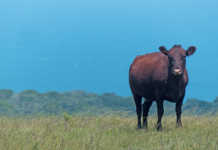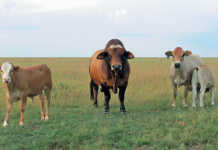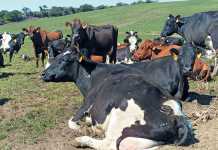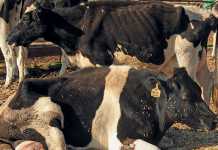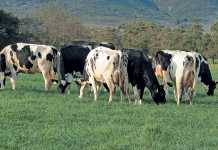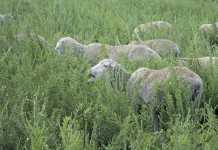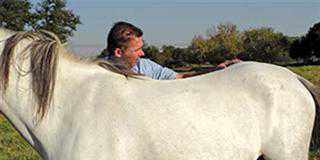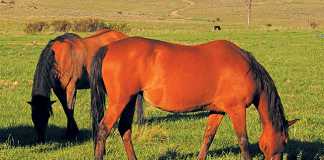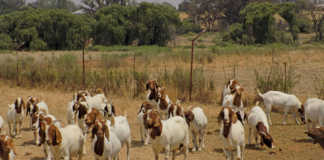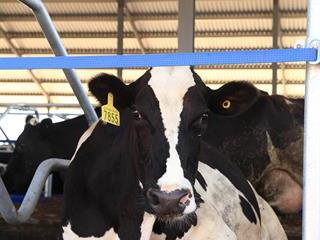
Six years ago, Marié du Toit decided to call it a day with the dairy she was running on her and her husband’s farm Goedertrou near Riebeek West in the Western Cape.
“The dairy wasn’t the main enterprise, so I had to make do with old infrastructure and equipment that kept breaking down,” she recalls. “Our herd size was limited to 420 cows, as the pastures would turn into one big muddy mess as soon as we stocked higher.”
Eight months later, however, husband Stephanus decided to restart the dairy – for good reasons. Marie explains that he has an integrated approach to farming in which the production activities complement one another.
“He has a good eye for quality animals. He buys beef cows with calves at auctions and sells the weaners at about two years. The cattle component allows us to make the most of our marginal soil and stubble lands. It also adds value to the wheat, clover and vetch rotations.
“Stephanus realised that dairy cattle would add even more value than would beef cows,” she says. Marié agreed to get involved in the dairy again, but only on certain conditions: she wanted an infrastructure upgrade and a more serious approach to dairying on the farm.
Holsteins and TMR
The Du Toits were concerned about their wet camps, and approached their dairy consultant, Chris Fourie, for help. He suggested that they convert from a pasture-based operation to an indoor TMR (total mixed ration) operation. “This meant we could expand the herd beyond the 420-cow limit of before,” Marié explains.
Yet, building a cow house still did not make economic sense. Then Stephanus bought in 350 Holstein cows from a dairy in Ladismith in the Klein Karoo that had closed down.
When they arrived at Goedertrou, the cows were milking an average of only 15l/ day on a restricted ration, and many of them had gone dry. “Despite the low production level per animal, more cows made a big difference to our bottom line,” she says. “It also made me more positive about cow housing.”
Many of these cows were sold along with the beef cattle. The remaining better quality cows are expected to produce far more milk during their next lactation. They are now on a balanced ration and have adapted to the change in environment. There are currently 360 cows in milk and they have recently been moved to new cow housing.
Bedding alternatives
Choosing the most suitable bedding for the cow cubicles proved difficult. Kurt Strahlendorf, director of Streamline Milking Services, suggested synthetic mattresses. He explained that although farmers in the region had generally used sand bedding, which is excellent for cow comfort, its abrasive nature is tough on equipment particularly pumps. Many TMR dairymen had therefore changed to use less abrasive bedding such as composted and reclaimed manure solids.
In this method, the liquid is squeezed out of slurry and the solid fraction is composted. During composting, temperatures can reach 60°C, which effectively sterilises the compost. With a recycled manure solids system, once potentially harmful pathogens are destroyed it is safe to use as bedding. A cow produces between 50kg and 70kg of manure a day and using this in bedding reduces wastage on the farm, says Kurt.
Compost bedding has disadvantages. It needs to be fluffed up regularly so that there is no hardening, and according to Kurt, studies have shown that it is no better than other types of bedding in terms of comfort and hygiene. “As a matter of fact, dairies using these systems may periodically experience a higher somatic cell count and mastitis rate,” he explains.
After studying the various options, the Du Toits opted to use the synthetic mattresses.
“I visited Sweden to see how the mattresses are used, as nobody in South Africa was using them at the time, and decided that this was the best option for our production conditions,” she says.
The mattresses consist of a 40mm thick polyurethane foam cushion covered with a 4mm two-ply layer of synthetic material and a 0,2mm polyethylene sheet. It is waterproof and resistant to manure, urine and milk acids, UV light and micro-organisms.
A light grip pattern helps a cow to lie down or stand up with confidence. “They’re durable, easy to keep clean and very comfortable,” Marié adds. A 10mm layer of reclaimed manure solids is spread on top of the mattress to absorb moisture and prevent friction. When the cows are introduced to the mattresses, this layer is made thicker to habituate the animals to the bedding.
To further improve conditions in the cow house, the walkways are covered with rubber matting to prevent the animals from slipping. This surface also improves hoof health. A concrete surface can be hard on a cow’s feet and cause tenderness and in some cases laminitis, resulting in production loss.
Independent decisions
Marié maintains that blindly copying what other farmers do in their cow houses is at the root of many problems in dairies today. ”They unwittingly copy each other’s mistakes,” she says. “We wanted to get everything right from the start, so we decided not to take any shortcuts.”
For example, the cubicle divider rails in the cow house consist of one piece of steel. Because cows like to rub against the railing there tends to be some loosening at the joints after a few years. “The cubicle divider railings we use have no joints, but they can be removed in an emergency by unscrewing the mounting bolts in the floor,” explains Marié.
The chances of a cow getting stuck are minimal and the dividers are designed to guide the natural movement of the animals when they lie down or get up. The low slope further prevents cows from getting stuck. A blue, flexible plastic brisket board at the head of the stall stops cows from moving too far into the cubicle when getting up, as this can cause them to fall. The brisket board’s flexible neck and front band also guide the cows’ movements and stop them from leaving at the front of the cubicle.
Ventilation
The current cow house can accommodate 500 cows and has been designed to keep them cool with minimum input. The roof has a 22° pitch, in contrast with the 18° pitch of most South Africa cow houses. “It improves ventilation and allows the cow house to stay a few degrees cooler inside than it is outside, which is important in South Africa where heat stress often has a negative impact on milk production.
Cows start showing heat stress and eating less when the temperature rises above 22°C,” explains Marié. The carefully planned roof pitch is complemented by high-volume, low-speed fans that help to provide ventilation. Just one of these big 1,5kW fans circulates more air than ten 1,2kW fans of the type commonly used in poultry houses. The fans switch on automatically when temperature and humidity levels rise above a certain level.
Good ventilation also helps to remove ammonia vapours, remove odours and keep fly numbers down.
Lighting
Darkness triggers the release of the sleep hormone melatonin, which has a negative impact on milk-producing hormones. The cow house is therefore fitted with 150 lux lighting. “Research has shown that inhibiting melatonin release with 16 hours of lighting at a minimum light level of 150 lux can boost milk production by up to 10%,” Kurt explains.
Simulating long summer days, when cows are naturally more active, this lighting regime translates into lower levels of melatonin. The cows are more active, have a higher feed intake and increased milk production. Marié expects the cow house and all the advantages that go with it to boost average milk production by between 1l/ day and 3l/ day.
She plans to grow the herd and will keep them on pasture until she has enough cows to build an additional house and ultimately milk 1 300 cows.
Email Marié du Toit at Marié[email protected] or Kurt Strahlendorf at [email protected].

